#conservation-restoration
Explore tagged Tumblr posts
Text
Intro!
Hey there! I´m Em (they/it), a conservation-restoration student at ESCRBCG in Galicia, Spain.
▸This blog is for me to post a bit of everything about conservation-restoration, from talking about how we do things here (which can be a bit different than other places, since every place applies their own criteria) to just memeing (about conservation-restoration).
▸Questions are more than welcome! Just keep things on topic and respectful 💙.
▸All of my posts will be in English, Galician and Spanish, though to make sure I don´t clutter anyone´s dash the last two will be under a ´read more` for anyone interested.
═══════════════════════════════════════════
Introdución!
Ola! Son Em (Elle/Ello), estudante de conservación-restauración na ESCRBCG en Galicia, España.
▸Este blog é para eu facer posts un pouco de todo relacionado coa conservación-restauración, dende falar de cómo facemos as cousas aquí (que pode ser un pouco diferente de outros sitios, xa que cada lugar ten os seus criterios) ata facer memes (sobre conservación-restauración).
▸As preguntas son sempre benvidas! Mantédeas no tema e respetuosas e xa está 💙.
▸Todolos meus posts estarán en inglés, galego e español; inda que para non encher ó dash de ninguén estes dous últimos idiomas estarán baixo un "read more" para aquelas persoas interesadas.
═══════════════════════════════════════════
¡Introducción!
Hola! Soy Em (Elle/Ello), estudiante de conservación-restauración en la ESCRBCG en Galicia, España.
▸Este blog existe para que yo pueda hacer posts sobre un poco de todo relacionado con la conservación-restauración, desde hablar sobre cómo hacemos las cosas por aquí (que puede ser distinto a cómo lo hacen en otros sitios, ya que cada lugar tiene sus propios criterios) hasta hacer memes (sobre la conservación-restauración)
▸¡Las preguntas son siempre bienvenidas! Mantenedlas en el tema y respetuosas y ya está 💙.
▸Todos mis posts estarán en inglés, gallego y español; Pero para no atestar el dash de nadie estos dos últimos idiomas estarán bajo un "read more" para aquellas personas interesadas.
#introduction#introdución#introducción#cultural heritage#heritage conservation#restoration#conservation-restoration#art conservation#art restoration#patrimonio cultural#conservación del patrimonio#restauración#conservación#conservación-restauración#hope this goes well!!!
4 notes
·
View notes
Text
If you aren't following the news here in the Pacific Northwest, this is a very, very big deal. Our native salmon numbers have been plummeting over the past century and change. First it was due to overfishing by commercial canneries, then the dams went in and slowed the rivers down and blocked the salmons' migratory paths. More recently climate change is warming the water even more than the slower river flows have, and salmon can easily die of overheating in temperatures we would consider comfortable.
Removing the dams will allow the Klamath River and its tributaries to return to their natural states, making them more hospitable to salmon and other native wildlife (the reservoirs created by the dams were full of non-native fish stocked there over the years.) Not only will this help the salmon thrive, but it makes the entire ecosystem in the region more resilient. The nutrients that salmon bring back from their years in the ocean, stored within their flesh and bones, works its way through the surrounding forest and can be traced in plants several miles from the river.
This is also a victory for the Yurok, Karuk, and other indigenous people who have relied on the Klamath for many generations. The salmon aren't just a crucial source of food, but also deeply ingrained in indigenous cultures. It's a small step toward righting one of the many wrongs that indigenous people in the Americas have suffered for centuries.
#salmon#dam removal#fish#animals#wildlife#dams#Klamath River#Klamath dams#restoration ecology#indigenous rights#Yurok Tribe#Karuk Tribe#nature#ecology#environment#conservation#PNW#Pacific Northwest
19K notes
·
View notes
Text
I've worked on an owl in a similar state from approximately 1890-1920s, this one might be QUITE old! That said, the eyes look weirdly matte (resin?) and it is not particularly faded, so it is (also) likely quite new. Fading depends on storage. I can't say much about the mount's pedestal, but it could be relatively new, I'd guess some time during the 1900s. But it's impossible to tell from these pictures, unfortunately, and might require chemical or x-ray testing to narrow a timeframe down without any identifying markers, such as a stamp or a conservator's name.
Nice choice of cleaning materials, be careful of inhaling or getting dust in your eyes as it can be toxic. I'm willing to offer further advice if you have questions!
It’s the weekend! And that means I had some time to get a closer look at the taxidermy owl that was being given away for free in my apartment lobby.
I mean just look at this boy! How could I resist?
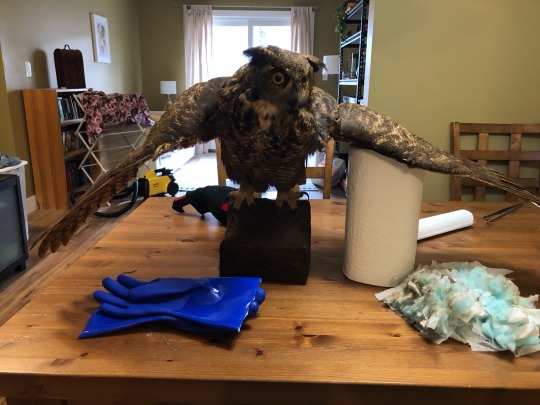
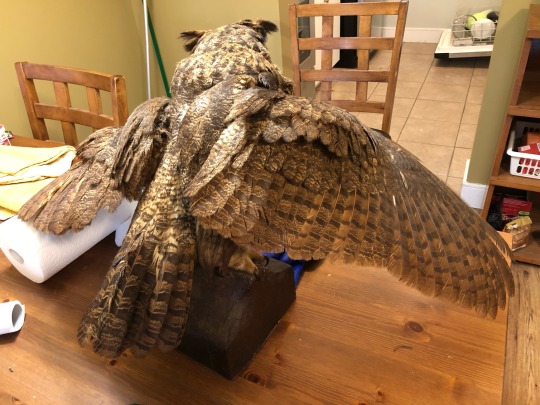
He is very obviously a Great Horned Owl, which just so happens to be the official bird of my Province. And the first thing I did after picking this guy up was double-check the laws about possessing raptor parts, and best I can tell is having a pre-existing owl mount is just fine.
I have no practical experience with taxidermy, but I’m hoping to patch him up.
The main issue is that his left wing is broken. Or more accurately almost completely ripped off. The skin on the underside of the wing connecting to the body is intact, but the skin under the scapulars is just barely attached.


I couldn’t get great photos as I didn’t want to damage the skin any further. But you can at least see that it’s stuffed with straw, and one of the wire apertures holding it up. I couldn’t tell through my gloves if the wire is snapped or just bent.
I couldn’t tell much about the state of the skin through the gloves (I need to grab some nitrile gloves next time I’m out), but I would say it’s almost but not quite paper dry.
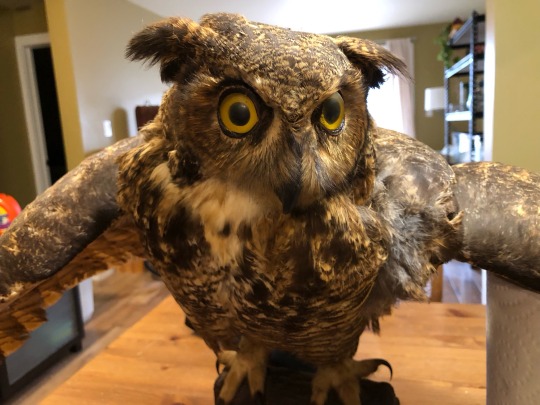

His face is a little wonky, but far from the worst I’ve seen on older taxidermy. The plaster in the beak seems a bit sloppy and is crumbling.

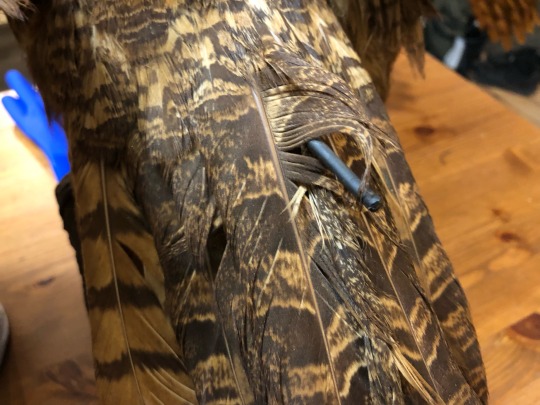
Here’s some more pictures of the wire aperture. The end on his head is usually covered by the feathers. I’m assuming the wires protruding the tail were meant to hold it up but just need to be repositioned back into place.

The base is made of wood, covered in some sort of plaster or epoxy, and hollow. I was hoping to find a date or something in there, but no such luck.
So far all I’ve done is start a slow and careful wipe-down to get all the dust off of him.
#taxidermy#contemporary taxidermy#conservation#restoration#conservation-restoration#natural history conservation
77 notes
·
View notes
Text
"England is celebrating the first pair of beaver kits born in the country since they were reintroduced back into the country’s north last year.
Landscape managers in England are beside themselves with surprise over the changes brought about by a single year of beaver residency at the Wallington Estate in Northumberland—with dams, mudflats, and ponds just appearing out of nowhere across the landscape.
Released into a 25-acre habitat on the estate last year, the four beavers at Wallington are part of a series of beaver returns that took place across the UK starting in 2021 in Dorset. Last year, GNN reported that Hasel and Chompy were released into the 925-acre Ewhurst Estate in Hampshire in January 2023, and the beavers that have now reproduced established their home in Wallington in July.
“Beavers are changing the landscape all the time, you don’t really know what is coming next and that probably freaks some people out,” said Paul Hewitt, the countryside manager for the trust at Wallington. “They are basically river anarchists.”
“This time last year I don’t think I fully knew what beavers did. Now I understand a lot more and it is a massive lightbulb moment. It is such a magical animal in terms of what it does.”
It’s believed that the only animal which alters the natural environment to the same extent as humans is the beaver. Their constant felling of trees to construct dams causes creeks to build up into pools that spill out during rainfall across the land, cutting numerous other small channels into the soil that distribute water in multiple directions.
Hewitt says that in Wallington this has translated to a frantic return of glorious wildlife like kingfishers, herons, and bats.
Recently the mature pair of beavers mated and produced a kit, though its sex is not yet known because beavers don’t have external genitalia.
These beaver reintroductions have led to a raft of beaver sightings around the country. Those at the National Trust working to rewild the beaver back into Great Britain hope the recovery of the landscape will convince authorities to permit further reintroductions to bigger areas."
-via Good News Network, July 16, 2024
#beaver#beavers#wild animals#rewilding#ecosystem#ecology#ecosystem restoration#conservation#climate action#biodiversity#good news#hope
4K notes
·
View notes
Text
From the article:
The new law aims to restore at least 20% of the EU's land and seas, with specific targets including reversing the decline of pollinators and restoring 25,000 kilometres of rivers to free-flowing conditions. This target is instrumental to align EU policy with global commitments made by almost 200 countries to restore and protect at least 30% of our planet’s degraded ecosystems by 2030. The legislation solidifies Europe's leadership in global biodiversity restoration and protection efforts, setting a powerful example for the rest of the world.
This law is in many ways the first of its kind and creates legally binding restoration targets for various ecosystems throughout the EU.
#nature restoration#EU#politics#good news#habitat#habitat restoration#ecosystem#ecosystem restoration#ecosystem conservation#conservation#habitat conservation#hope#hopepunk#climate change#environment#endangered species#biodiversity
939 notes
·
View notes
Text
Dandelion News - February 15-21
Like these weekly compilations? Tip me at $kaybarr1735 or check out my Dandelion Doodles!
1. Solar farms managed for nature boost bird abundance and diversity, new study finds

“There were more than twice as many farmland birds in the well-managed solar farms compared with the intensively farmed land, and nearly 16 times as many woodland birds. […] Overall, diversity was 2.5 times higher, while woodland birds were nine times more diverse.”
2. Washington judge blocks Trump’s gender-affirming care ban, says it's unconstitutional in multiple ways

“This marks the second time in a week that a judge has stood in the way of Trump’s attacks on trans kids. [… The ruling grants] a temporary restraining order that halts enforcement of provisions in Trump’s directive that would cut off federal funding to medical institutions that provide gender-affirming care to minors.”
3. Fog harvesting could provide water for arid cities

“17,000 sq m of mesh could produce enough water to meet the weekly water demand of [… the] urban slums. 110 sq m could meet the annual demand for the irrigation of the city's green spaces. Fog water could be used for soil-free (hydroponic) agriculture, with yields of 33 to 44lb (15 to 20kg) of green vegetables in a month.”
4. Audubon Applauds Bipartisan Federal Effort to Protect Delaware River Basin with Critical Reauthorization Bill

“The bill would […] ensure long-term conservation and restoration efforts, expand the official definition of the basin to include Maryland, and prioritize projects that serve small, rural, and disadvantaged communities. […] The watershed provides important year-round habitats and critical migratory stopovers for approximately 400 bird species[….]”
5. mRNA vaccines show promise in pancreatic cancer in early trial
“Half of the people in the study — eight of the participants — responded to the vaccine, producing T cells that targeted their tumors. […] Just two of the patients who had a response to the vaccine had their cancer return during the three-year follow- up, compared to seven of the eight who did not respond to the vaccine treatments.”
6. Minn. Lt. Gov. Flanagan Makes It Official; She's running for U.S. Senate

“[Flanagan has] “championed kitchen-table issues like raising the minimum wage, paid family and medical leave, and free school meals.” If elected, Flanagan, a tribal citizen of the White Earth Nation, would become the first Native American female U.S. senator in history.”
7. Federal Funding Restored for Low-Income Alabama Utility Assistance After Outcry

“A program meant to help low-income Alabamians pay their utility bills has resumed two weeks after it was canceled due to an executive order from President Donald Trump. […] “We can confirm the funds are reaching those affected by the previous pause[….]””
8. Modeling study suggests Amazon rainforest is more resilient than assumed

“[Previous] studies were either conducted with global climate models that used a simplified representation of convection [or were on a regional scale….] According to the computations, mean annual precipitation in the Amazon does not change significantly even after complete deforestation.“
9. States are moving forward with Buy Clean policies despite Trump reversal

““Buy Clean is a great example of how states and other nonfederal actors can continue to press forward on climate action, regardless of what the federal government does,” said Casey Katims, executive director of the U.S. Climate Alliance, a bipartisan coalition of two dozen governors.”
10. The rewilded golf courses teeming with life

“A wildflower meadow, ponds, scrub habitat, coastline and even an area of peat bog can be found on this little 60-acre (24-hectare) plot, which boasts roe deer, otters, lizards, eels and a huge array of insects and birds.”
February 8-14 news here | (all credit for images and written material can be found at the source linked; I don’t claim credit for anything but curating.)
#hopepunk#good news#nature#us politics#solar power#solar panels#solar energy#birds#biodiversity#gender affirming care#transgender#trans rights#trans healthcare#water conservation#habitat#migratory birds#vaccines#vaccination#mrna vaccine#pancreatic cancer#cancer#native american#alabama#low income#amazon rainforest#rainforest#executive orders#climate action#golf course#habitat restoration
501 notes
·
View notes
Text
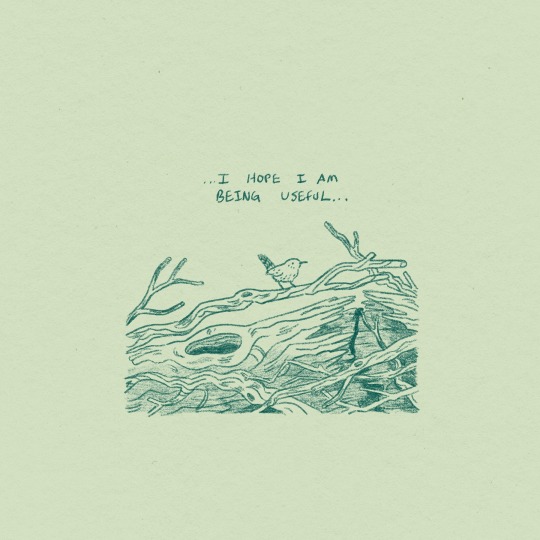
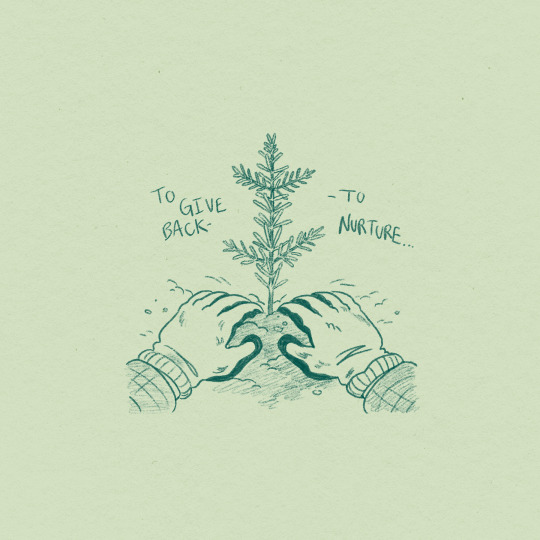
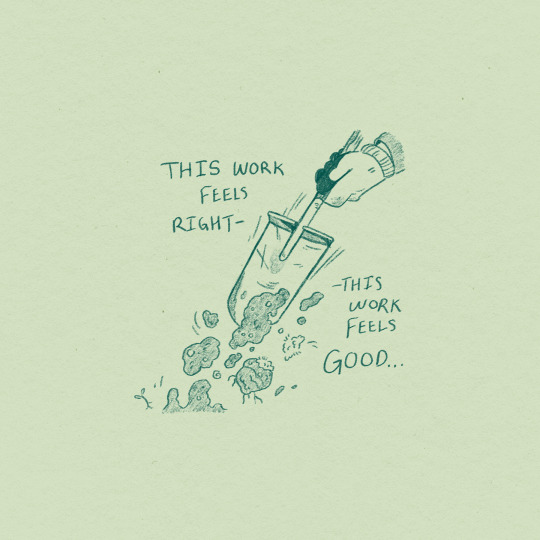
Small journal about my new job, plus a silly little bonus
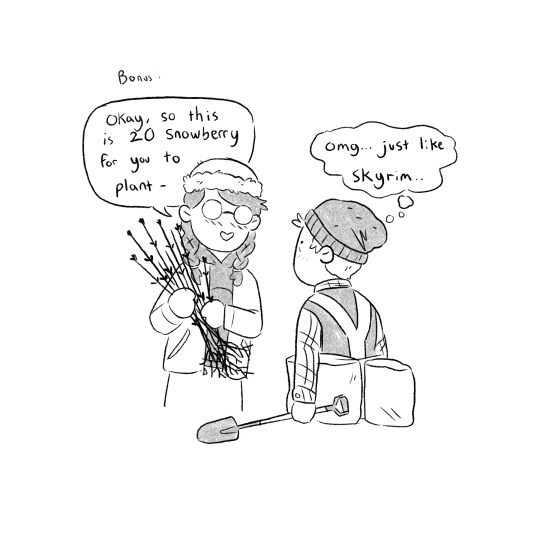
#my art#artists on tumblr#illustration#lgbt artists#nature art#comics#conservation#habitat restoration#journal
2K notes
·
View notes
Text

zutara week 2024 | #3 echoes
echoes of the past are slow to fade
#zk reaction to the conservative fire nation council#after a meeting about changes to foreign policy lol#zutara week 2024#zutara week#zutara#katara x zuko#zuko x katara#day 3#echoes#the rest of the gaang is helping restore their hometowns after the war#aang and katara take turns in the fire nation
289 notes
·
View notes
Text
Life is getting harder, and so, we must get better at it.
Climate change and species extinction and ecosystem collapse are happening quickly. They are spiraling out of control. Even many Ecosystems that are supposed to be the most stable in their regions are facing decline. There are runaway effects, each thing that gets worse makes the next thing get worse faster, more disastrously. Each of these systems becomes less resilient the more of its redundancies are stripped away.
And yet, we can also have cascading effects. I am seeing controlled burns turn the plantation pines into savannas again, for the first time in 200 years, they are burning now, right now, where they would never have imagined to burn a year ago. I am seeing people talk about planting native plants. The nurseries here are selling out of them faster than they can restock. If you ask, they will say “This did not happen last year”. The foundations that have been being built by ecologists over the past half century, and maintained against brutal colonialism by indigenous peoples, are seeping out into the community. I see people talking about river cane, and pitcher plant, and planting paw paw and persimmon and sassafras and spice bush. These things are returning. Even now, in the worst drought in known history of my area, I see more butterflies than last year, because we have put in more of their host plants, their overwinters. We are learning. We are beginning. We are being born into a world of ecology; we are breaking the green wall of blur that defines our settler nonrelationship with nature. The irises are returning to Louisiana, the black bear too. The oysters are returning to Mobile Bay. I hear talk of gopher apples and river oats from the mouths of children. I see the return of the chinquapin, and her larger sister chestnut. It is slow but it is also so fast. It is growing at new trajectories, new rises. Each of these becomes it’s own advocate when planted in space and put in relationship.
We are not doomed. We must claw back from the brink. We must find each other and we must exchange seeds. We must learn to pull invasive species. We must win others over through earnestness and full bellies, through kindling the spark of ecological joy, and then we must show them the way. We must be learning the way ourselves in the meantime. We must teach the children the names we were not told, that were forgotten; how to recognize these friends.
When things are spiraling towards despair and death we must be that spiral towards life and utter utopia. We must build ourselves into full participants in our ecological systems.
As life gets harder, we must get better at it.
1K notes
·
View notes
Text

Sugarcane is a widely grown crop in the Nile Basin, but its destructive effects on soils, water resources and biodiversity have become increasingly apparent.
As the thirsty crop draws down water resources, aquatic species like the critically endangered Nubian flapshell turtle suffer a loss of habitat, forage and nesting sites.
In an effort to revive soils, diversify diets and incomes, and boost water levels that many animals rely on, communities are implementing agroforestry projects in lieu of monocultures.
The resulting “food forests” attract an array of wildlife while refilling wetlands and river systems where the culturally important flapshell turtles swim.
#good news#nile river#africa#kenya#nubian flapshell turtle#food forest#restoration#turtles#agroforestry#environmentalism#science#environment#nature#animals#conservation#sugarcane
596 notes
·
View notes
Text

If there is magic on this planet, it is contained in water
- LOREN EISELEY
#water view#water art#water conservation#water everywhere#water energy#water element#water is life#water magic#water nymph#toya's tales#style#toyastales#toyas tales#art#july#summer#red and blue#red carpet#area rug#handmade rug#carpets and rugs#persian rugs#water quality#water reflection#water resources#water restoration#water ripples#water rights#water tribe#nature
197 notes
·
View notes
Text
Excerpt from this story from EcoWatch:
Fulfilling current land restoration pledges in 115 countries would require only a small amount of the global annual GDP, a recent analysis has found. Successful implementation would require about 0.04% to 0.27% of global annual GDP, totaling about $311 billion to $2.1 trillion.
The researchers analyzed costs of 243 land restoration projects happening globally and found that the median cost ranged from $185 per hectare to $3,012 per hectare, with an overall median cost of $1,691 per hectare. Lower-cost opportunities include forest management for $185 per hectare, passive regeneration ($513 per hectare), grazing management ($631 per hectare) and assisted natural regeneration ($804 per hectare).
“Passive regeneration is basically just fencing off an area and leaving it alone,” Dewy Verhoeven, lead author of the study and Ph.D. candidate at Wageningen University & Research, told Mongabay News. “Those costs are very low, maybe you have to install a fence and that’s it. But the opportunity costs are very large because you cannot use the land anymore.”
Projects with the highest median costs include agroforestry ($2,390 per hectare), cross-slope barriers ($2,562 per hectare), irrigation ($2,886 per hectare) and silvopasture ($3,012 per hectare), which integrates trees and pasture for grazing livestock on the same land.
In total, land degradation projects would add up to about 0.38% to 2.65% of global GDP for one year; however, the authors noted that spreading the cost out over a decade would lower the annual cost to just 0.04% to 0.27% of global GDP. The authors published these findings in the journal Land Degradation & Development.
While the total percentage is small, an even distribution of costs or distributing costs by project location would place a higher burden on lower income countries. The report authors found that most projects are concentrated in sub-Saharan Africa as well as South and Southeast Asia, with sub-Saharan Africa accounting for almost half of all global land restoration pledges.
64 notes
·
View notes
Text
This is HUGE news! Sea otters have been absent from Oregon shorelines for more than a century due to overhunting for fur. While Washington and California have healthy populations, Oregon hasn't seen any new otters move in, other than the occasional transient. This is due largely to the fact that they are not normally migratory animals, and so are more likely to stick around relatively close to their birthplaces. Since all the sea otters of Oregon were exterminated to make coats and other fur products, there was no remaining population to rebuild locally.
However, reintroduction could make a difference by deliberately relocating sea otters from other areas to Oregon, particularly in places that have lots of food for them, like sea urchins. This grant would fund research in finding the best places to reintroduce them and the best existing populations to draw from, among other tasks that need to be addressed before the otters can meet their new homes.
This grant is an incredibly important move forward in returning this keystone species to a part of its native range. Bringing back sea otters would vastly improve the health of kelp forests in the ocean, which are currently being decimated by an overpopulation of sea urchins. In turn, healthier kelp forests means better marine biodiversity offering more food and shelter for a wider range of species, giving them more resilience in the years to come.
#good news#positive news#conservation#environment#animals#wildlife#nature#animal welfare#ecology#restoration ecology#habitat restoration#sea otters#otters#mustelids#science#Oregon#PNW#hopepunk#endangered species#extinction
2K notes
·
View notes
Text
The insects and flowering plants that provide protection and essential nutrition for sage-grouse chicks are disappearing. Industrial development, along with impacts such as drought, wildfire, and invasive species that are amplified due to climate change have degraded and destroyed millions of acres of vital sage grouse habitat. You can take action today to help.
Tell the Biden Administration you support plans to protect and restore sagebrush habitat so sage-grouse—and many other species—can survive.
231 notes
·
View notes
Text
"The Lower Ninth Ward of New Orleans has recently witnessed an incredible eco-renaissance following decades of damage and neglect.
Led by a local community development group, a 40-acre wetlands park has been restored to glories past with hundreds of local trees that attract over a hundred species of birds, plus joggers, picnickers, and nature lovers besides.
The story begins with Rashida Ferdinand, founder of Sankofa Community Development Corporation (CDC). Growing up in this historic part of New Orleans, where Black homeownership thrived, where Fats Domino was born, and where locals routinely went out into the wetlands to catch fish and crustaceans, she watched as it suffered from years of neglect.
Poor drainage, ruined roads, illegal trash dumping, and unmitigated damage from hurricanes slowly wasted the wetland away until it was a derelict eyesore.
In the name of restoring this wild heritage indicative of the culture in the Lower Ninth, and in order to protect her communities from flooding, Ferdinand founded the Sankofa CDC, and in 2014 entered into an agreement with the City of New Orleans for the restoration of Sankofa—a 40-acre section of neglected wetlands in the heart of the Lower Ninth.
The loss of Sankofa’s potential to dampen flooding from storms meant that over the years dozens of houses and properties were flooded and damaged beyond the ability of the inhabitants to recover. Forced out by a combination of nature’s fury and government failure, the cultural heritage of the community was receding along with the floodwaters.
Ferdinand knew that restoring natural flood barriers like Sankofa was key to protecting her community.
“Hurricane protection is a major concern in the community, but there’s a lack of trust in the infrastructure systems that are supposed to protect us,” Ferdinand told the Audubon Society.
Today, Sankofa Wetlands Park is a sight to behold. Hiking trails snake through a smattering of ponds and creeks, where bald cypresses and water tupelo trees continue to grow and cling to the ground even during storms. Picnic benches have appeared, wheelchair-accessible trails connect sections of the park to parts of the Lower Ninth, and local businesses are seeing more visitors.
It needed a lot of work though. Thousands of invasive tallow trees had to be uprooted. 27,000 cubic meters of illegally dumped trash compacted into the dirt had to be removed. A 60-year-old canal dug by the US Army Corps of Engineers had to be disconnected, and all new native flora had to be planted by hand.
Audubon says that Ferdinand routinely can’t believe her eyes when she looks at the transformation of Sankofa into its current state.
“Seeing butterflies, birds, and other pollinators in the park is a sign of a healthy ecosystem,” she says. “All we had to do was create the right conditions.”
Slated for official completion in 2025 with an outdoor amphitheater, interpretive signage, and additional trails, Ferdinand and the CDC have their eyes set on an even larger area of wetlands to the north of Sankofa.
Along the way, Ferdinand and the CDC attracted many helping hands, and entered into many partnerships, But the catalyst for change arose from the spirit and determination of one woman in the right place at the right time, for the benefit of hundreds in this historic heart of a historic city."
-via Good News Network, September 17, 2024
#new orleans#louisiana#nola#united states#wildlife#wetlands#ecology#ecological restoration#conservation#good news#hope
3K notes
·
View notes
Text
Only four months after dams blocking migration were removed, the first Chinook salmon traveled 230 miles to return to the Klamath River Basin. This was the first fish to come home to their ancestral migration routes since 1912.
Over 100 years shut out and it only took them four months to return home once they had the chance.
From the article:
“The return of our relatives the c’iyaal’s is overwhelming for our tribe. This is what our members worked for and believed in for so many decades,” said Roberta Frost, Klamath Tribes Secretary. “I want to honor that work and thank them for their persistence in the face of what felt like an unmovable obstacle. The salmon are just like our tribal people, and they know where home is and returned as soon as they were able[.]"

#hope#good news#dam removal#salmon conservation#river conservation#indigenous conservation#endangered species#environment#biodiversity#hopepunk#chinook salmon#salmon migration#habitat restoration
2K notes
·
View notes